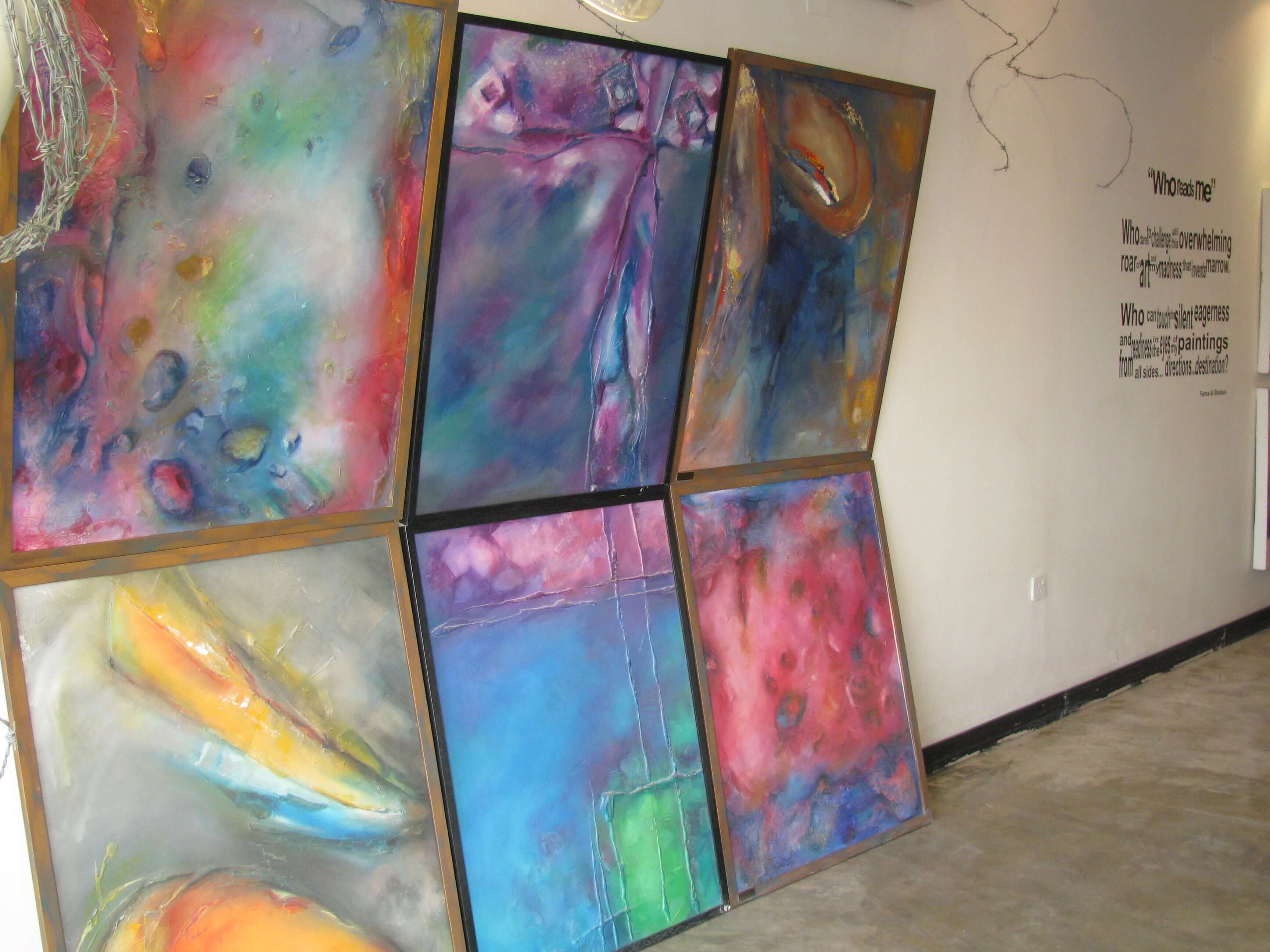Lifestyle
Sink or Swim; Renowned Artist Fatma Al Shebani’s Early Work in Painting

In life, one truly has just two options. Sink or swim. Most would like to think they would swim and yet most end up sinking, stuck in a place they never really intended to be. After being trapped by societal standards and traditions, contemporary artist Fatma Al Shebani chose to swim. With that choice, she placed herself in society’s line of fire and opened herself up to the art world’s criticism. She rebelled, broke barriers, and made a name for herself.
For over 15 years she has reached people across the world with her art. From Qatar to the Western world and to Palestine, there remains little doubt that she has left a significant impact and solidified her place in the art world. The unique style and voice behind her paintings and sculptures have allowed her to stand out. Every piece she creates retains a piece of herself through the story she aims to construct. Still, much like anything worthwhile, she traveled a long and winding road to accomplish all that she has.

Art always constituted a major part of Shebani’s life. From a young age, she painted and wrote poetry. Her pursuit of higher education at Qatar University also centered around art. Shebani claims that her studying art at university was a pure coincidence, but it nevertheless demonstrates her deep connection with the craft. Art was, perhaps, ingrained in her. The need to create has seemingly always flowed through her veins and intertwined with her soul. Even without consciously deciding to pursue a career as a professional artist, Shebani found herself drawn to the creation of art.
As time went on, Shebani’s life took slight detours. She married and started a family. Shebani had no intention of becoming an artist, but she still created and joined group exhibitions. Her separation from her husband in 2003 pushed her to rediscover herself and recalibrate her professional goals. After attaining freedom and deciding to pursue this creative passion, in spite of the views of those around her, she began to truly shine and find her voice. She separated herself from the crowd and carved out a space in which she now expresses herself, however she pleases.

Every artist has a start, Fatma Al Shebani’s journey – like many– began with painting. Now, she is well known for her metal work and sculptures, pieces that bridge traditional and modern Qatari culture. Her paintings, however, from her own perspective hold equal weight in her portfolio. Shebani’s paintings are often seen as unconventional. She broke the rules of art much like she broke the many conventions placed on her by society. Through painting, she explores the abstract, while also experimenting with color and texture. She allows her free spirit and curiosity to guide her in creating, which results in dynamic pieces that captivate audiences as they carefully explore every inch of the canvas. Her sculptures tell a story, but her paintings reveal layers of her ‘true self’.
In every one of Shebani’s paintings, it is difficult to know exactly where to look first. The paint itself acts to guide the viewer, drawing their eyes to certain parts as though they move through a world of Shebani’s creation. The broad range of colors used in each piece only adds to the creation. Often, the color schemes she employs consist of gentle hues, both warm and cool, but, on occasion, her work makes use of bright, eye-catching, contrasted colors. Shebani demonstrates breadth solely through the many different color combinations she utilizes. Her experimentation with color reflects her own constant personal evolution and willingness to embrace change. Every piece is different and reflects a different aspect of her identity.

Like color, texture and dimension play a major role in her painting process. When one thinks of paintings on canvas it can be difficult to imagine anything other than a 2D piece of art. Shebani breaks that boundary through exaggerated texture. There is a certain depth and physicality to the art she creates. Once again, she shifts from typical conventions in order to bring something new to her audience. She does not shy away from being different and creating something ‘unusual’. Instead, she embraces her defiant nature, going against the grain and doing so masterfully
Shebani once floated idly, slowly sinking into a life that never suited her. Eventually, she dived deep into the oceans of the art world and took control of her narrative. Her start was slow, but once she recognized her true calling, her art began to shine in new and exciting ways. At first glance, her abstract art may seem purely aesthetic in value, however, when one takes into consideration the personality behind the work, the disparate dimensions of the artist become apparent.
Lifestyle
Wanda Knight on Blending Culture, Style, and Leadership Through Travel

The best lessons in leadership do not always come from a classroom or a boardroom. Sometimes they come from a crowded market in a foreign city, a train ride through unfamiliar landscapes, or a quiet conversation with someone whose life looks very different from your own.
Wanda Knight has built her career in enterprise sales and leadership for more than three decades, working with some of the world’s largest companies and guiding teams through constant change. But ask her what shaped her most, and she will point not just to her professional milestones but to the way travel has expanded her perspective. With 38 countries visited and more on the horizon, her worldview has been formed as much by her passport as by her resume.
Travel entered her life early. Her parents valued exploration, and before she began college, she had already lived in Italy. That experience, stepping into a different culture at such a young age, left a lasting impression. It showed her that the world was much bigger than the environment she grew up in and that adaptability was not just useful, it was necessary. Those early lessons of curiosity and openness would later shape the way she led in business.
Sales, at its core, is about connection. Numbers matter, but relationships determine long-term success. Wanda’s time abroad taught her how to connect across differences. Navigating unfamiliar places and adjusting to environments that operated on different expectations gave her the patience and awareness to understand people first, and business second. That approach carried over into leadership, where she built a reputation for giving her teams the space to take ownership while standing firmly behind them when it mattered most.
The link between travel and leadership becomes even clearer in moments of challenge. Unfamiliar settings require flexibility, quick decision-making, and the ability to stay calm under pressure. The same skills are critical in enterprise sales, where strategies shift quickly and no deal is ever guaranteed. Knight learned that success comes from being willing to step into the unknown, whether that means exploring a new country or taking on a leadership role she had not originally planned to pursue.
Her travels have also influenced her eye for style and her creative pursuits. Fashion, for Wanda, is more than clothing; it is a reflection of culture, history, and identity. Experiencing how different communities express themselves, from the craftsmanship of Italian textiles to the energy of street style in cities around the world, has deepened her appreciation for aesthetics as a form of storytelling. Rather than keeping her professional and personal worlds separate, she has learned to blend them, carrying the discipline and strategy of her sales career into her creative interests and vice versa.
None of this has been about starting over. It has been about adding layers, expanding her perspective without erasing the experiences that came before. Wanda’s story is not one of leaving a career behind but of integrating all the parts of who she is: a leader shaped by high-stakes business, a traveler shaped by global culture, and a creative voice learning to merge both worlds.
What stands out most is how she continues to approach both leadership and life with the same curiosity that first took her beyond her comfort zone. Each new country is an opportunity to learn, just as each new role has been a chance to grow. For those looking at her path, the lesson is clear: leadership is not about staying in one lane; it is about collecting experiences that teach you how to see, how to adapt, and how to connect.
As she looks to the future, Wanda Knight’s compass still points outward. She will keep adding stamps to her passport, finding inspiration in new cultures, and carrying those insights back into the rooms where strategy is shaped and decisions are made. Her legacy will not be measured only by deals closed or positions held but by the perspective she brought, and the way she showed that leading with a global view can change the story for everyone around you.
-

 Tech5 years ago
Tech5 years agoEffuel Reviews (2021) – Effuel ECO OBD2 Saves Fuel, and Reduce Gas Cost? Effuel Customer Reviews
-

 Tech6 years ago
Tech6 years agoBosch Power Tools India Launches ‘Cordless Matlab Bosch’ Campaign to Demonstrate the Power of Cordless
-

 Lifestyle6 years ago
Lifestyle6 years agoCatholic Cases App brings Church’s Moral Teachings to Androids and iPhones
-

 Lifestyle5 years ago
Lifestyle5 years agoEast Side Hype x Billionaire Boys Club. Hottest New Streetwear Releases in Utah.
-

 Tech7 years ago
Tech7 years agoCloud Buyers & Investors to Profit in the Future
-

 Lifestyle5 years ago
Lifestyle5 years agoThe Midas of Cosmetic Dermatology: Dr. Simon Ourian
-

 Health7 years ago
Health7 years agoCBDistillery Review: Is it a scam?
-

 Entertainment6 years ago
Entertainment6 years agoAvengers Endgame now Available on 123Movies for Download & Streaming for Free
